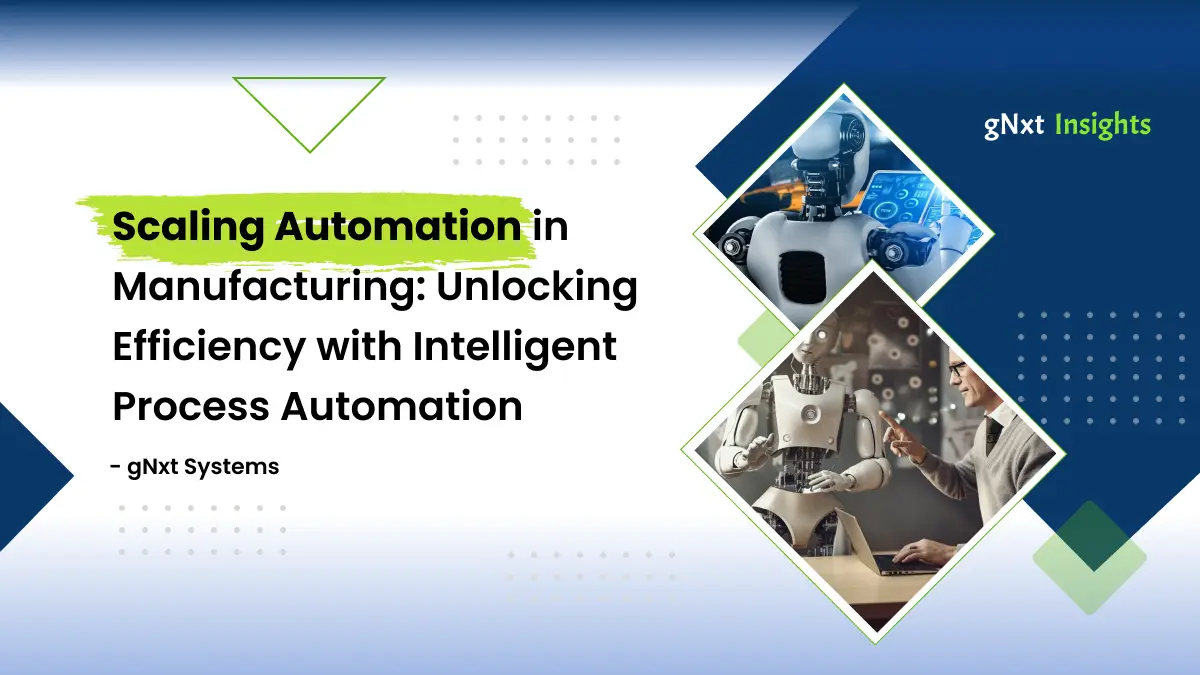- February 5, 2025
- by gNxt Systems
Scaling Automation in Manufacturing: Unlocking Efficiency with Intelligent Process Automation (IPA)
In the era of Industry 4.0, manufacturing companies are embracing advanced technologies to stay competitive, improve productivity, and streamline operations. Among these technologies, Intelligent Process Automation (IPA) has emerged as a transformative tool. By automating repetitive, rule-based tasks, IPA empowers manufacturers to achieve unprecedented levels of efficiency, reduce costs, and improve operational agility.
Here’s an in-depth look at how scaling automation with IPA can revolutionize the manufacturing sector.
1. What is Intelligent Process Automation in Manufacturing?

IPA uses software bots to mimic human actions for executing repetitive and time-consuming tasks. Unlike physical robots, IPA operates in the digital space, automating processes such as data entry, inventory management, and compliance tracking. By integrating IPA into their operations, manufacturers can bridge gaps between disparate systems, enhance accuracy, and free up human workers for higher-value tasks.
2. Key Benefits of implementing IPA to your Manufacturing Process
Scaling automation with IPA delivers numerous advantages:
a. Enhanced Efficiency and Productivity
IPA bots work 24/7, performing tasks faster and more accurately than humans. This boosts production timelines and reduces errors in critical processes like supply chain management, production planning, and quality assurance.
b. Cost Reduction
By automating repetitive tasks, IPA minimizes the need for manual labor in areas like administrative workflows, leading to significant cost savings. Additionally, it reduces operational inefficiencies, which can translate into long-term financial benefits.
c. Improved Data Accuracy
Human errors in data processing can lead to costly mistakes. IPA ensures consistent and error-free data entry, enhancing decision-making across the organization.
d. Scalability and Flexibility
IPA solutions can be easily scaled to meet fluctuating demands. Whether it’s expanding automation to new departments or handling seasonal production spikes, IPA adapts to the evolving needs of manufacturers.
e. Increased Employee Satisfaction
By offloading mundane tasks to bots, employees can focus on strategic initiatives, innovation, and customer engagement, leading to improved job satisfaction and productivity.
3. Applications of Intelligent Process Automation
IPA can streamline multiple areas of manufacturing operations:
a. Supply Chain Management
IPA automates tasks like:
- Tracking shipments in real-time.
- Managing inventory levels.
- Generating purchase orders and invoices.
This ensures a smoother supply chain and timely delivery of raw materials and finished goods.
b. Production Scheduling
Automating production scheduling reduces downtime, optimizes resource allocation, and ensures timely completion of orders. IPA bots can analyze data to predict and mitigate production bottlenecks.
c. Quality Control and Compliance
IPA bots can:
- Monitor production data for quality assurance.
- Generate compliance reports for regulatory authorities.
- Track incidents and manage corrective actions.
This ensures high product quality and adherence to industry regulations.
d. Order Processing and Fulfillment
IPA streamlines order processing by automating tasks such as:
- Validating order details.
- Updating ERP systems.
- Coordinating logistics for timely delivery.
e. Maintenance and Asset Management
Predictive maintenance is another area where IPA shines. It can:
- Monitor equipment performance.
- Schedule maintenance tasks.
- Alert teams to potential issues before they result in costly downtime.
4. Challenges in Scaling Intelligent Process Automation and How to Overcome Them

While Intelligent Process Automation offers immense benefits, scaling it across an organization comes with challenges. Here’s how manufacturers can address them:
a. Lack of Standardized Processes
IPA thrives on well-defined, rule-based tasks. Conducting process audits and standardizing workflows ensures successful implementation.
b. Integration with Legacy Systems
Legacy systems can pose integration hurdles. By using middleware or APIs, manufacturers can bridge these gaps and ensure seamless automation.
c. Resistance to Change
Employee resistance is a common barrier. Transparent communication, proper training, and highlighting the benefits of RPA can ease the transition.
d. Cybersecurity Risks
Automation can introduce vulnerabilities if not managed securely. Implementing robust cybersecurity protocols and regular audits is critical.
5. The Future of IPA in the Manufacturing Sector
As manufacturing moves toward greater digital transformation, IPA will continue to evolve. Future trends include:
a. Intelligent Automation
Combining IPA with Artificial Intelligence (AI) and Machine Learning (ML) will enable bots to handle more complex, decision-based tasks.
b. Integration with IoT
IPA will integrate with Internet of Things (IoT) devices to automate data processing and real-time decision-making based on sensor inputs.
c. Hyperautomation
Hyperautomation involves automating end-to-end processes by combining IPA, AI, and advanced analytics. This will drive unprecedented efficiency and innovation in manufacturing.
6. How gNxt Systems Can Help Scale Automation
At gNxt Systems, we specialize in helping manufacturers implement and scale IPA solutions. Our unique capabilities include:
- Custom Solutions: Tailored to meet the specific needs of your manufacturing operations.
- End-to-End Automation Support: From process discovery and design to implementation and optimization.
- Seamless Integration: Bridging IPA with ERP, CRM, IoT, and other enterprise systems.
- Ongoing Training and Support: Ensuring your team can maximize the benefits of automation.
Partnering with gNxt Systems empowers your organization to unlock the full potential of Intelligent Process Automation and drive sustainable growth.
Conclusion
IPA is not just a tool—it’s a catalyst for transformation in manufacturing. By scaling automation with IPA, manufacturers can achieve greater efficiency, reduce costs, and remain competitive in a rapidly changing industry.
As we move into 2025 and beyond, leveraging IPA will be a key differentiator for forward-thinking manufacturers. Contact gNxt Systems today to explore how we can help you scale automation and unlock new levels of efficiency in your operations.
Read this blog by gNxt Systems. It might interest you: What is HyperAutomation?
About Author

gNxt Systems is an IT professional services and product development company that follows Agile and Rapid development methodologies.


